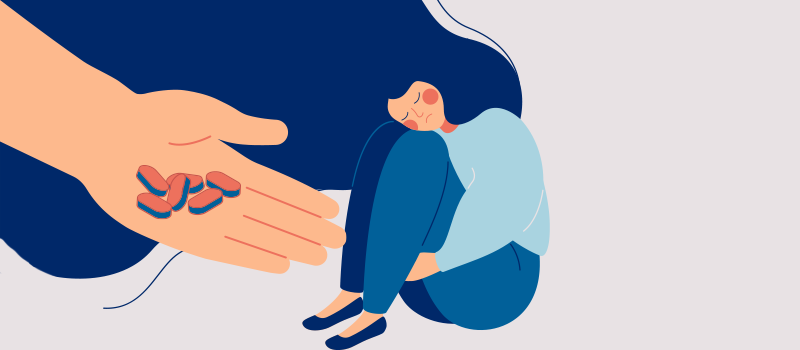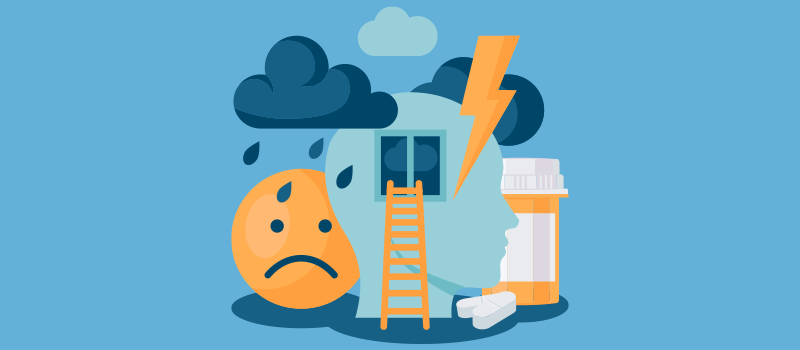What’s the Buzz
The Bee Healthy Blog
Valium vs. Ativan: What’s the Difference?

Valium and Ativan belong to a group of medications called benzodiazepines (also called “benzos”). They are prescription drugs that are used to relieve anxiety and other psychiatric health disorders. The generic name for Valium is diazepam, and lorazepam is the generic name for Ativan.
Please continue reading to learn more about the similarities and differences between Valium and Ativan. This drug information will help you decide, along with your healthcare provider, which medication, Ativan vs. Valium, might be better for you.
Are Valium and Ativan the same?
Valium and Ativan belong to the same class of medications but are not the same. There are differences in how long the effects of each medicine last, indications, approved age range, side effects, and drug interactions.
What are the similarities between Valium and Ativan?
Both Valium and Ativan are benzodiazepines (benzos). They work by increasing GABA activity. GABA (gamma-aminobutyric acid) is a neurotransmitter that reduces certain signals; as a result, they decrease brain activity and generate a calming effect.
Other similarities are listed below. Both medications:
- Can only be obtained only with a doctor’s prescription.
- Are available in both brand name and generic form.
- Come as oral tablets and injection solutions.
- Need to be taken 2-4 times a day.
- Are schedule IV controlled substances due to their potential for misuse, abuse, and addiction.
- Can cause withdrawal symptoms if discontinued abruptly.
- Are intended for short-term use (no more than 4 months).
- Are covered by most insurance plans.
What are the main differences between Valium vs. Ativan?
Generic Name
Valium is the brand name of the generic medication diazepam. Ativan is the brand name of the generic medication lorazepam.
Age Range
Valium is approved for use in adults and children 6 months of age and older. Ativan is approved for use in adults and children 12 years of age and older.
Uses
Valium is a prescription drug used to treat anxiety disorders, muscle spasms, seizures, and alcohol withdrawal symptoms. In addition, Valium may be used off-label before surgeries to help induce sedation.
Ativan is also a prescription medication used to treat anxiety disorders, insomnia, and seizure disorders, including status epilepticus. Additionally, Ativan may be used off-label for alcohol withdrawal symptoms, panic attacks, muscle spasms, and sedation.
Dosage
In addition to other factors such as age, and other concurrent medications, the doses depend on the condition being treated and the route of administration.
The typical dose of Valium is 2 mg to 10 mg orally 2-4 times a day, depending on the severity of symptoms. The typical dose of Ativan for the treatment of anxiety is 2 mg to 6 mg orally 2-3 times a day with a maximum dose of 10 mg per day.
Your healthcare provider will give you instructions regarding the most appropriate dose for your condition. It is very important not to take these medications at a higher dose, more frequently, or for a longer duration than prescribed.
Duration of Action
Valium (diazepam) is a long-acting benzodiazepine with a half-life of around 49 hours for healthy individuals. Half-life is the time it takes for the amount of drug to reduce by half in the body. Compared to Ativan, Valium takes longer to be eliminated from the body. In other words, Valium stays in the body longer. It takes about 60 to 90 minutes for Valium to kick in; however, some people start to experience the relaxing effect of this medication within 30 minutes.
Ativan (lorazepam) is an intermediate-acting benzodiazepine.It leaves the body more quickly than Valium and has a half-life of approximately 18 hours. It takes about 2 hours for Ativan oral tablets to take full effect, and it will take longer to see the effects of this medication if you take it with food.
Shorter-acting agents in this class are available when a shorter duration of action is desired. Midazolam (Versed) is commonly used for anxiety and sedation in critical care settings or before surgery. In those instances, the injectable form is typically preferred over the oral form for a quicker onset of action. Examples of other short acting benzodiazepines are temazepam (Restoril), triazolam (Halcion) and flurazepam (Dalmane).
Coverage and Cost
Most insurance plans cover generic Valium, i.e., diazepam. The average retail price for 30 tablets of brand name Valium 5 mg is $226.
Ativan is covered by most insurance plans. The average retail price for 30 tablets of the brand name Ativan 1 mg is $1,325.
You can get these medicines at discounted prices with a BuzzRx Valium (diazepam) discount coupon or Ativan (lorazepam) discount coupon.
Side Effects
Common side effects of Valium include tiredness, drowsiness, muscle weakness, and feeling unsteady. Other common side effects include dizziness, nausea, and confusion.
Possible side effects of Ativan include dizziness, drowsiness, and unsteadiness. Negative side effects can also include nausea, weakness, and confusion.
Both Valium and Ativan can cause serious adverse effects, especially at high doses and for elderly populations. These include respiratory depression (slow and shallow breathing) leading to respiratory failure, low blood pressure, blurred vision, memory problems, irritability, agitation, and sleep disturbances. Also, both medicines can be habit-forming and carry a risk of dependency and addiction.
Drug Interactions
Both drugs interact with other medications. However, Ativan has fewer unfavorable interactions with other drugs compared to Valium.
Warnings
Benzodiazepines like Ativan & Valium can have drug interactions with other similar drugs that also affect the central nervous system, such as anticonvulsants, antipsychotics, antidepressants, barbiturates, and sedatives. Taking these medications together can increase the risk of drowsiness, confusion, and impaired cognition. Taking benzodiazepines with opioids may increase the risk of respiratory depression, coma, and even death, especially at higher doses.
Valium, Ativan, and other benzodiazepines have a higher risk of causing unpleasant withdrawal symptoms if treatment is stopped suddenly. Your doctor will guide you on how to reduce the dose of these drugs slowly.
Both Valium and Ativan are Schedule IV controlled substances because they have some potential for abuse and dependence. These medications are generally not recommended for long-term treatment.
Both drugs are in pregnancy category D. Taking Valium and Ativan during pregnancy can lead to birth defects.
Consuming alcohol while on benzodiazepines can increase the risk of side effects like drowsiness and dizziness.
Taking more than one benzodiazepine together can lead to an overdose with serious side effects like respiratory depression, coma, and even death.
Is Valium or Ativan better?
Many people wonder—What is stronger, Valium or Ativan?
Based on research and current understanding, both Valium and Ativan are equally effective in treating anxiety symptoms and other conditions.
The choice between one or the other drug will depend on the condition being treated, your tolerability of the negative side effects, and the efficacy of the medication. Some other factors to consider are your current medications, age, and medical history.
Your doctor can give you further information and help you decide which drug is right for you.
References:
- https://www.ncbi.nlm.nih.gov/books/NBK470159/
- https://www.ncbi.nlm.nih.gov/books/NBK532890/
- https://www.ncbi.nlm.nih.gov/books/NBK537022/
- https://www.dea.gov/sites/default/files/2020-06/Benzodiazepenes-2020_1.pdf
- Lorazepam. In Micromedex [Electronic version].Greenwood Village, CO: Truven Health Analytics. Retrieved August 17, 2022, from http://www.micromedexsolutions.com/
- Diazepam. In Micromedex [Electronic version].Greenwood Village, CO: Truven Health Analytics. Retrieved August 17, 2022, from http://www.micromedexsolutions.com/












SOCIAL